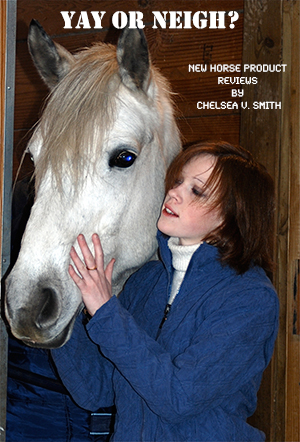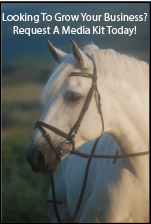Simple Keys to Unlock Resistance in Dressage Training
By Nikki Alvin-Smith
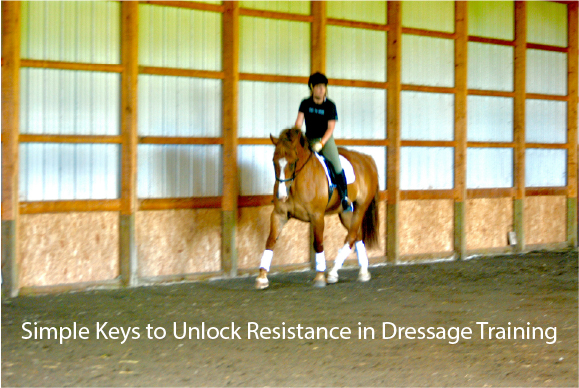
As a Grand Prix trainer making a horse from start to finish is always a journey filled with anticipation and excitement, learning and laughter. It is important to me that each step or hoof fall of this journey builds the horse up, not breaks it down. And of course, this also applies to the student rider.
All horses can look spectacular when excited. When working a horse under saddle making the horse look fabulous very often leads to false work to showcase the horse’s gaits, compromising the essence of the equine partner; the horse’s noble spirt. A facet all horses exude from day one on this planet. As a horse breeder I cherish that starting moment of the horse/human connection when a foal hits the floor and imprint training begins. Of course the mare mom present always being included in the experience of first handling and nurturing of the foal. I love working with maiden mares as they appreciate our human help the most and it creates a bond like no other between mare and human. If it’s done right.

Why then do horses later become resistant to the human connection? In some cases their innate willingness to relate to us and oblige with submission to small tasks at birth seemingly dissipated and diminished or even missing altogether.
As a seasoned professional trainer horses that come into my private yard for training often express resistance to work or exhibit tension when given aids or direction. As a world travelled clinician I also often encounter students whose horses showcase clear indications of shutting down, lacking understanding of what is being asked of them or simply being unable to answer demands due to soundness of mind or body or both.
When it comes to learned resistance in dressage training, it doesn’t matter the breed of horse or what country the rider hails from or where they have trained. All are equally affected by negative experiences. Whatever the horse breed, from the ever forward moving warmbloods to the intense natured Iberian horses and the many other breeds in-between that have entered at A under my watchful trainer’s eye, similar resistances to training aids are common.
Unlock Your Horse’s Mind
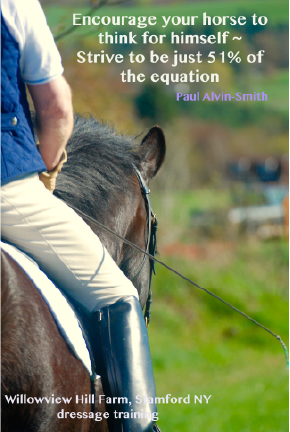 The key to unlocking your horse’s body is to unlock his mind. That may sound complicated but it isn’t. A simple understanding of how to literally and metaphorically connect with your horse comes from knowledge and accomplishment of two principles. I like to call them working latitude and longitude.
The key to unlocking your horse’s body is to unlock his mind. That may sound complicated but it isn’t. A simple understanding of how to literally and metaphorically connect with your horse comes from knowledge and accomplishment of two principles. I like to call them working latitude and longitude.
As I have written so many times before, we want the horse to be relaxed. And he can’t relax if we don’t. And vice-versa. But who is in charge?? Let it be 51% you as his rider.
But how do we create relaxation? Sure. We want to focus on rhythm as a metronome which will help divest the horse and rider of tension.
Slower posting, slower paces, can all help regulate your equine partner’s hoof steps into a soft rhythm and sync his mind away from tension and toward the required ‘Schwung’. Cadence work can aid in building acceptance and understanding of the aids and increase suppleness. But aside from these useful habits when working any horse of any breed how can you improve the connection across the horse’s back to the rider’s waiting soft, yielding but firm hands?
Latitude and Longitude
Throughout dressage training of the horse from basics to Grand Prix, you’ll note the tests from whichever country, all include aspects that require bending and extending the horse’s spinal processes from top to tail, or rather poll to tail.
From the 1st level U.S.A. lengthening across diagonals to the leg yield (a non-classical move alongside the turn on the forehand that as a classicist I am not fond of though understand the reasoning to include it in tests), to circles that become ever smaller and later counter canters and change-in-hand (zigzag or Niggli Wiggly as we used to call it), all paces and all movements are designed to gradually ‘gymnasticize’ the horse to build stronger musculature and increase suppleness.
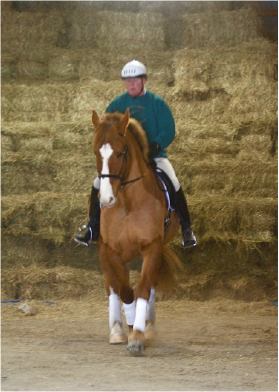 Very simply put - when a horse resists aids to connect to the rein longitudinally; the remedy is to work the horse laterally. When a horse resists aids to work laterally; the remedy is to work the horse longitudinally.
Very simply put - when a horse resists aids to connect to the rein longitudinally; the remedy is to work the horse laterally. When a horse resists aids to work laterally; the remedy is to work the horse longitudinally.
So for example, a horse that stalls out after two strides of half pass needs to be ridden forward and straight for at least a stride or two providing renewed energy. While a horse that is not moving truly across its back and accepting a soft rein contact to his bit on a straight line, will benefit from being asked to migrate between a shoulder fore position to each side for several strides each side at a time with one straight stride to transition between the two.
Being effective at resolving connection issues and having prompt remedies in the rider or trainer tool box that the horse can accept and quickly learn is important in all dressage work. This exercise of correcting longitudinal connection using the simplest lateral aids is sometimes called shoulder in and shoulder out, where the latter includes taking the horse’s head to the outside of the ring with appropriate leg aids to match.
Leg Aids to Match You Ask?
Legs: The inside leg is on the girth creating energy and is tapping (non-supportive) on the same side to which the horse’s head is slightly bent. Just his eye or eyelashes visible to the rider on the same side, depending on his level of training. On a trained horse the poll of the horse should still be the highest point and his nose slightly in front of the vertical. Unless the rider is utilizing a back stretch exercise for suppling on a bend both laterally and longitudinally as shown here. While the outside leg is behind the girth controlling the bend of the hindquarters to keep the horse from falling out.

Reins: The outside and inside rein have a soft contact from rider’s hands to bit but not looped. The inside one should be as soft as possible to maintain a yield to the bend. Neither reins are holding. A delicate give and take action is important on both reins, i.e. a half-halt in rhythm on the outside rein to correct pace and to stop the shoulder falling out with the softest give and take to the inside to maintain the inside bend. The give action (release) should always be larger than the take. As you switch the horse in its spinal bend from one side to the other, that switch should always begin with the change in leg aids rather than hand first. Then a split second or stride later (the straight stride between) switch the head position and rein aids.
Seat: There is no need to force any movement in the seat. Let the change in your leg position do the work. Sit up relaxed, not hollow in the back or taught, breathe and smile.
This exercise is best tested or employed on the ¼ or ¾ line or off the track on an inside line 2 feet off the wall down the long side. Later as the horse becomes more supple the exercise can be employed as a mild correction can be on circles. As the horse progresses through its training this exercise will be invaluable in schooling the counter canter. It helps the horse to learn self-carriage and balance.
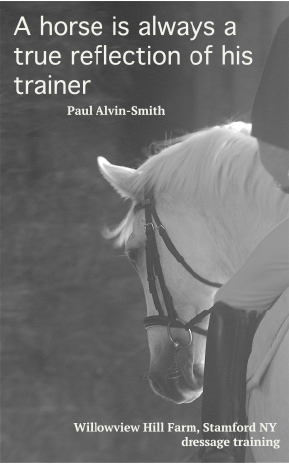 Remember whatever you do as a rider the horse will copy. You hold your breath, so does he. You hold your leg against his side instead of a gentle tap, then he’ll hold his side pushing against your leg instead of yielding to it. A horse is always a mirror image or reflection of his trainer/rider in all aspects.
Remember whatever you do as a rider the horse will copy. You hold your breath, so does he. You hold your leg against his side instead of a gentle tap, then he’ll hold his side pushing against your leg instead of yielding to it. A horse is always a mirror image or reflection of his trainer/rider in all aspects.
It is easier to do than it sounds. This exercise is never ‘sawing’ the horse’s mouth. Neither is it faked by a rider dropping their hand to create an open rein to the inside to pull the horse’s head down.
You know the routine, elbows of the rider should be brushing their sides, hands 4” apart and thumbs on top, fingers closed. An open or flat hand is an unkind hand and as I’m also fond of saying, “The rider’s legs and seat belong to the horse, the rider’s hands/arms and torso above the waist and of course head belong to the rider, the reins belong to both.”
It’s That Simple
There are many varietal figures, transitions and movement sequences that can be employed when training any aspect of dressage. But keeping things simple, especially for riders new to dressage seeking to find the connection with their mounts is the best way.
A thinking rider will make a thinking trainer. And that is always the goal. There is nothing better as a ‘trainer’s trainer’ at this point in my career, than seeing a trainer I’ve worked with impart the knowledge they have learned over and over again, horse after horse, student rider over student rider.
As a trainer and a writer I am constantly inspired by the ripple effect of sharing knowledge and collaborating with others with what we have learned. It is always heartening to witness these transformations happen. And that is true not just of training horses and equestrian pursuits, but most things in life.
Perfection is always something to strive for in training. Just as a trot may need to be slightly slow and less active than ideal for a rider to learn how to let the horse’s hip movement determine their own, so small simple asks at the beginning create understanding of the basic tenets of training that need to be consistently repeated throughout the course of making a horse up to a ‘finished’ horse.
To know where you are truly going, you do need guidance from someone that understands (likely learned from their own past training errors and education). This knowledge of understanding what the order of go should be based on the level of importance of a particular gymnastic exercise and its priority training wise has to include a view of the long-term results.
Often riders even at advanced levels are instructed to get back to basics with their FEI horses. There are many errors that can occur as shortcuts employed or a lack of understanding of the exact purpose of an exercise or how to completing the task correctly. A good example is the wrong placement and timing of leg aids to a canter from walk or trot in the early years. When learned incorrectly this will haunt the rider when it comes time to execute a half pass trot off a corner. As a result of wrong training methods the horse will break into one stride of canter rather than move sideways in the trot gait, losing marks in competition for the movement before the half pass exercise itself has even begun.
None of us know what we don’t know. Never be afraid to ask your trainer for more detailed instruction on aids to be used and their timing if you are asked to implement an exercise you are not sure how to complete. While for the most part we can quickly determine where the gaps in knowledge exist, it is always a good idea to be sure you are working on the same page and clarification can help.
Most importantly, enjoy the training process. Both your own and that of your horse. There is nothing better than working it out together. And anything you successfully learn together with your own horse will always be right there whenever you need it. Those moments when things ‘click’ are one of the best feelings on the planet.
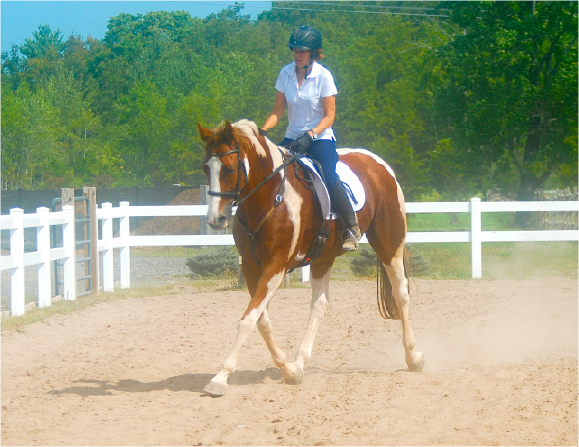
About the author: Nikki Alvin-Smith is an international Grand Prix dressage trainer/clinician who has competed in Europe at the Grand Prix level earning scores of over 72%. Together with her husband Paul, who is also a Grand Prix rider, they operate Willowview Hill Farm a private horse breeding/training farm in Stamford, NY.

